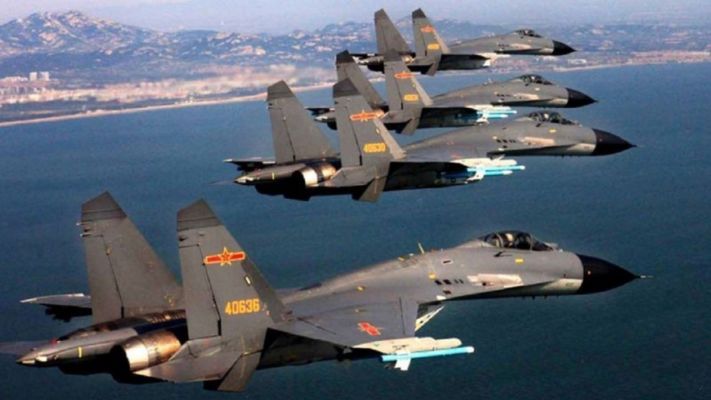
MOSCOW, (BM) – In recent days, tension on the disputed stretch of the Sino-Indian border in the Ladakh region has increased dramatically. In addition to physical clashes between border detachments, both countries began to actively pull military equipment to the disputed site and transfer aircraft to nearby military airfields.
The author of the Wings of War Telegram channel offers to compare the air forces of the parties to the conflict.
Air Force of the People’s Liberation Army
The Chinese Air Force occupies third place in the world in the number of military aircraft of all types [except drones], second only to the United States and Russia. According to the annual World Air Forces 2020 study, as of December 2019, the total number of aircraft was 3,210 units:
It should be noted that current data on the number and types of Chinese drones are not available in the public domain. But, various kinds of information leaks allow us to conclude that Beijing is actively developing several types of strike UAVs at once, both aircraft and helicopter types. However, there is one reconnaissance and strike UAV, which is widely known throughout the world. Beijing often publishes photo and video materials of the training flights of these drones, and also exports them to Arab and other countries. We are talking about CAIG Wing Loong, which in the amount of more than 100 units is in service with the Chinese army.
The basis of fighter aviation is replicas of the Soviet MiG-21 family – J-7 aircraft. But, given the numbers above, we can confidently say that more modern fighters will soon allow China to abandon the aging. The strategic H-6 bombers, which are copies of the Soviet Tu-16s of the 60s of the XX century, are also obsolete, but the constant modernization of these aircraft allows them to remain a formidable force. China also has a serious and modern fleet of attack helicopters of its own design and production.
In general, over the past 10 years, China’s aviation industry has reached a high level of development. The assembly and delivery of new units of military aircraft and helicopters to the troops takes place on an ongoing basis, this is confirmed by satellite images of Chinese military airfields published in the media. Close military-technical cooperation with Russia in the supply of aircraft, their maintenance and the exchange of technological information also plays a significant role. Unknown remains the percentage of aircraft in a state of alert, which will be able to fly in the near future, if the situation so requires.
The Chinese aviation has not taken part in real combat operations since the last century, but the constant exercises and trainings of the Chinese air force pilots make it possible to judge their potentially high combat readiness. Serious training, strong morale and a large number of various aviation equipment are the main trump cards of the PLA Air Force.
Indian Air Force
The Indian Air Force ranked fourth in the number of military aircraft of various types. According to World Air Forces 2020, at the end of 2019, the Indian army had 2123 aircraft in service:
The main fighter of India is the Su-30MKI. MiG-21, despite numerous upgrades, is already surviving its age and is gradually being decommissioned from the Air Force. Of the new products, New Delhi also has Rafale aircraft and Tejas proprietary light fighters. Serial production of the latter has only just begun, so the potential quantity and delivery time cannot yet be determined. The Indian Air Force does not and does not anticipate strategic combat aircraft. The attack helicopter fleet is just starting its upgrade through the procurement of US Apache AH-64E.
India still relies on the purchase of military aircraft in other countries, such as the United States, Russia and France. Own aircraft industry practically does not receive development. Pilots also regularly conduct training flights and participate in exercises. In addition, the Indian Air Force relatively recently participated in the conflict with Pakistan. True, the results of these air duels for New Delhi were disappointing. India will want to rehabilitate for its failures in the conflict with Pakistan, therefore, in the possible confrontation with China, a huge role will be played by the desire of Indian pilots to show everything that they are capable of.
Who will win a possible conflict in the sky?
Both countries have a powerful quantitative composition of the Air Force and approximately the same level of training for pilots. In the event of their collision in the air, each pilot will be able to observe a desire to show himself, which will result in many fatal errors. An important role will also be played by the way in which each side wages a war in the air. If China decides to use its most advanced fighter J-20 (despite their small number) and Su-35, then India will have very few chances to win duels even using the Su-30
There is a third party to the possible conflict – Russia, which has its own economic and geopolitical interests. It will be optimal for her to supply both sides with as many modern fighters and other aircraft as possible. At the same time, it will be very important for Russia to prevent a direct clash between Beijing and New Delhi so as not to take sides on a possible conflict. The support of one of the countries automatically means the loss of good relations with the second.
The diplomatic relaxation of tension, after successfully concluded arms supply contracts, is a good scenario for Russia. And for China and India, in principle, too.